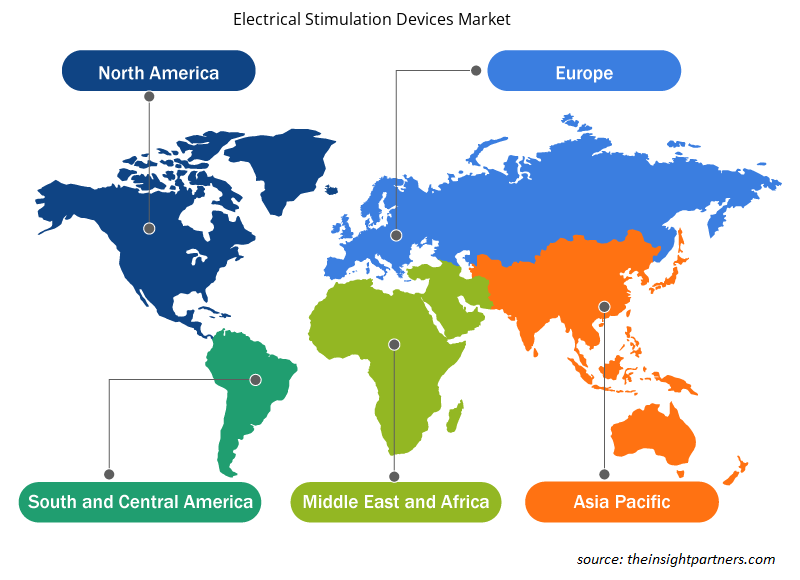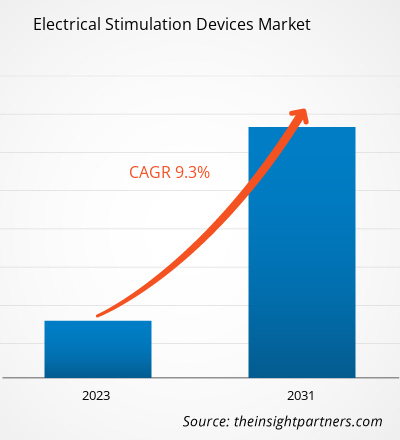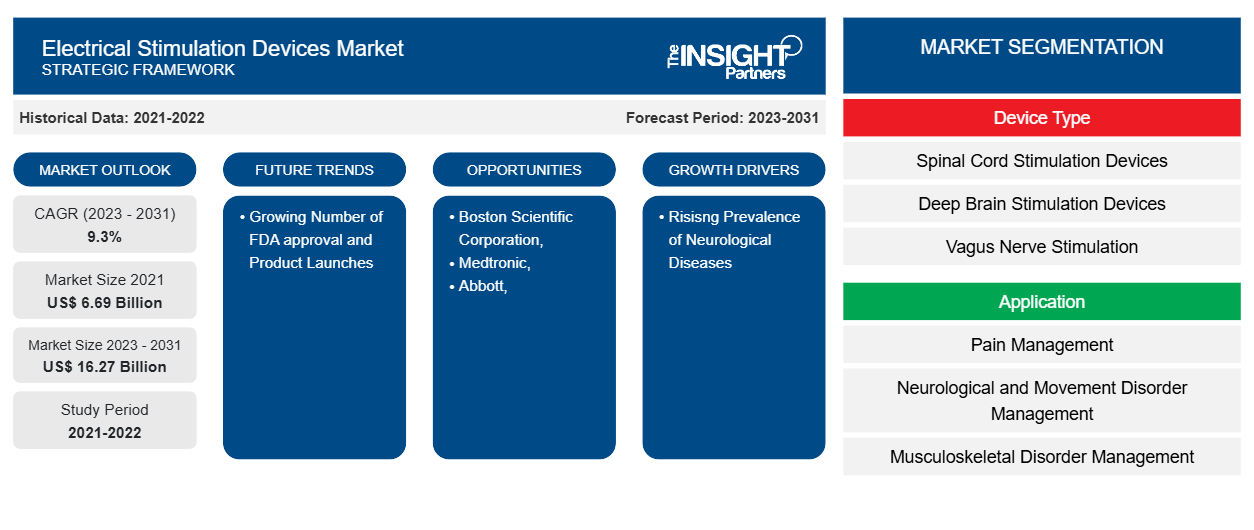El tamaño del mercado de dispositivos de estimulación eléctrica se estimó en US$ 6.69 mil millones en 2021 y US$ XX mil millones en 2023 y se espera que alcance los US$ 16.27 mil millones para 2031. Se estima que registrará una CAGR del 9,3% hasta 2031. Es probable que la creciente prevalencia de enfermedades neurológicas, la creciente prevalencia de enfermedades crónicas y los dispositivos de estimulación eléctrica portátiles sigan siendo tendencias clave del mercado de dispositivos de estimulación eléctrica.
Análisis del mercado de dispositivos de estimulación eléctrica
El dolor crónico es una condición dolorosa compleja y debilitante que afecta a millones de personas en todo el mundo. El dolor se define como aquel que dura más de 12 semanas y persiste durante un mes o incluso un año. Algunas de las causas más comunes del dolor crónico son las lesiones, los traumatismos, la artritis, el daño a los nervios, entre otros. Este dolor también afecta la vida socioeconómica diaria de los pacientes. Se espera que la creciente prevalencia del dolor crónico impulse el crecimiento del mercado. Según el Centro de Control y Prevención de Enfermedades, durante 2021, se estima que el 20,9% de los adultos estadounidenses experimentaron dolor crónico, lo que fue igual a la estimación informada del 20,4% en 2016. Las condiciones de dolor crónico incluyen principalmente el dolor de espalda, rodillas y brazos, así como otras afecciones musculoesqueléticas. Los dispositivos de estimulación eléctrica tienen la capacidad de reducir el dolor en gran medida. Estos beneficios de los dispositivos de estimulación eléctrica, junto con la creciente prevalencia del dolor crónico, impulsan el crecimiento del mercado de dispositivos de estimulación eléctrica.
Descripción general del mercado de dispositivos de estimulación eléctrica
El crecimiento del mercado se atribuye a algunos factores impulsores clave, como la creciente prevalencia de enfermedades neurológicas y dolor crónico. Sin embargo, es probable que el alto costo del tratamiento de los dispositivos muestre un impacto negativo en el crecimiento del mercado durante el período de pronóstico. El mercado mundial de dispositivos de estimulación eléctrica está segmentado por región en América del Norte, Europa, Asia Pacífico, Medio Oriente y África y América del Sur y Central. El mercado más grande para los dispositivos de estimulación eléctrica está en manos de la región de América del Norte. Los factores que influyen en el crecimiento del mercado incluyen el aumento de las actividades de investigación y desarrollo, el aumento de las inversiones financieras por parte de los actores del mercado y la creciente adopción de dispositivos de estimulación eléctrica dentro de las organizaciones públicas y privadas y dentro de los actores del mercado.
Personalice este informe según sus necesidades
Obtendrá personalización en cualquier informe, sin cargo, incluidas partes de este informe o análisis a nivel de país, paquete de datos de Excel, así como también grandes ofertas y descuentos para empresas emergentes y universidades.
- Obtenga las principales tendencias clave del mercado de este informe.Esta muestra GRATUITA incluirá análisis de datos, desde tendencias del mercado hasta estimaciones y pronósticos.
Impulsores y oportunidades del mercado de dispositivos de estimulación eléctrica
La creciente prevalencia de enfermedades neurológicas favorece el mercado de dispositivos de estimulación eléctrica
Las enfermedades neurológicas representan una carga sustancial para los sistemas de salud en términos de identificación, tratamiento y manejo de enfermedades. Varias enfermedades neurológicas observadas con frecuencia incluyen la narcolepsia, la enfermedad de Parkinson , la enfermedad de Alzheimer, la esclerosis múltiple, la atrofia muscular espinal (AME), la distrofia muscular de Duchenne y otras. Un nuevo estudio importante publicado por The Lancet Neurology muestra que, en 2021, más de 3 mil millones de personas en todo el mundo vivían con una afección neurológica. Durante las últimas décadas, ha habido varias actividades de investigación y desarrollo relacionadas con el diagnóstico y el manejo de enfermedades neurológicas. Es probable que los avances en los sistemas de atención médica y la modernización de los sistemas de diagnóstico mejoren los procesos de detección de enfermedades neurológicas raras. Estos avances, junto con la creciente prevalencia de enfermedades neurológicas, están impulsando el crecimiento del mercado de dispositivos de estimulación eléctrica.SMA), Duchenne muscular dystrophy, and others. A major new study released by The Lancet Neurology shows that, in 2021, more than 3 billion people worldwide were living with a neurological condition. Over the past few decades, there have been various research and development activities pertaining to the diagnosis and management of neurological diseases. Advancements in healthcare systems and modernizing diagnostic systems are likely to enhance the screening processes for rare neurological diseases. Such advancements, coupled with growing prevalence of neurological diseases, are driving the growth of the electrical stimulation devices market.
Número creciente de aprobaciones de la FDA y lanzamientos de productos: una oportunidadEl mercado de dispositivos de estimulación eléctrica
Las empresas del mercado de dispositivos de estimulación eléctrica están realizando cada vez más actividades de investigación y desarrollo para introducir productos más innovadores. Los nuevos dispositivos de estimulación eléctrica están equipados con plataformas terapéuticas avanzadas que pueden facilitar un alivio del dolor más eficaz. Además, la creciente adopción de dispositivos de estimulación eléctrica también está dando lugar a la introducción de nuevos productos. Por ejemplo, en enero de 2024, la FDA aprueba el estimulador cerebral profundo recargable de Medtronic para el párkinson, la distonía, los temblores esenciales y otras afecciones de salud como el síndrome de fatiga crónica y la epilepsia. Además, en marzo de 2023, Neuro20 Technologies Corp, una empresa de fabricación de dispositivos médicos portátiles, anunció que la Administración de Alimentos y Medicamentos de los Estados Unidos (FDA) había aprobado la solicitud de aprobación previa a la comercialización 510(k) de la empresa para su sistema Neuro20 PRO. Por lo tanto, se considera que el aumento de la tasa de adopción seguida del lanzamiento del producto tendrá un impacto positivo en el mercado de dispositivos de estimulación eléctrica, ya que representa una oportunidad para los fabricantes de dispositivos médicos.
Análisis de segmentación del informe de mercado de dispositivos de estimulación eléctrica
Los segmentos clave que contribuyeron a la derivación del análisis del mercado de dispositivos de estimulación eléctrica son el tipo de dispositivo, la aplicación y el usuario final.
- Según el tipo de dispositivo, el mercado de dispositivos de estimulación eléctrica se divide en dispositivos de estimulación de la médula espinal, dispositivos de estimulación cerebral profunda , dispositivos de estimulación del nervio vago (VNS), dispositivos de estimulación del nervio sacro (SNS), dispositivos de estimulación eléctrica gástrica (GES), dispositivos de estimulación nerviosa eléctrica transcutánea (TENS), otros dispositivos. El segmento de dispositivos de estimulación de la médula espinal tuvo la mayor participación del mercado en 2023; mientras que se anticipa que el segmento de dispositivos de estimulación del nervio sacro (SNS) registre el porcentaje de CAGR más alto en el mercado durante el período de pronóstico.VNS) Devices, Sacral Nerve Stimulation (SNS) Devices, Gastric Electrical Stimulation (GES) Devices, Transcutaneous Electrical Nerve Stimulation (TENS) Devices, Other Devices. The Spinal Cord Stimulation Devices segment held the largest share of the market in 2023; whereas the sacral nerve stimulation (SNS) devices segment is anticipated to register the highest CAGR % in the market during the forecast period.
- Por aplicación, el mercado está segmentado en Manejo del Dolor, Manejo de Trastornos Neurológicos y del Movimiento, Manejo de Trastornos Musculoesqueléticos, Manejo del Metabolismo y del TGI, Manejo de la Incontinencia, Otras Aplicaciones. El segmento de Manejo del Dolor tuvo la mayor participación del mercado en 2023; además, se espera que el segmento registre la CAGR más alta del mercado durante 2023-2031.CAGR in the market during 2023–2031.
Análisis de la cuota de mercado de los dispositivos de estimulación eléctrica por geografía
El alcance geográfico del informe de mercado de dispositivos de estimulación eléctrica se divide principalmente en cinco regiones: América del Norte, Asia Pacífico, Europa, Oriente Medio y África, y América del Sur/América del Sur y Central. América del Norte ha dominado el mercado de dispositivos de estimulación eléctrica. En América del Norte, Estados Unidos tiene la participación significativa del mercado de dispositivos de estimulación eléctrica. El crecimiento del mercado en el país está impulsado principalmente por la creciente adopción de dispositivos de estimulación eléctrica, la prevalencia sustancial del dolor crónico y el lanzamiento de productos en el mercado local. Por ejemplo, Zynex, Inc., una innovadora empresa de tecnología médica especializada en la fabricación y venta de dispositivos médicos no invasivos para el manejo del dolor, la rehabilitación y el monitoreo de pacientes, anunció que recibió la autorización de la Administración de Alimentos y Medicamentos de los Estados Unidos ("FDA") para el dispositivo de estimulación eléctrica neuromuscular ("NMES") de próxima generación M-Wave.
Perspectivas regionales del mercado de dispositivos de estimulación eléctrica
Los analistas de Insight Partners explicaron en detalle las tendencias y los factores regionales que influyen en el mercado de dispositivos de estimulación eléctrica durante el período de pronóstico. Esta sección también analiza los segmentos y la geografía del mercado de dispositivos de estimulación eléctrica en América del Norte, Europa, Asia Pacífico, Oriente Medio y África, y América del Sur y Central.

- Obtenga datos regionales específicos para el mercado de dispositivos de estimulación eléctrica
Alcance del informe de mercado sobre dispositivos de estimulación eléctrica
| Atributo del informe | Detalles |
|---|---|
| Tamaño del mercado en 2021 | 6.69 mil millones de dólares estadounidenses |
| Tamaño del mercado en 2031 | US$ 16,27 mil millones |
| CAGR global (2023 - 2031) | 9,3% |
| Datos históricos | 2021-2022 |
| Período de pronóstico | 2023-2031 |
| Segmentos cubiertos | Por tipo de dispositivo
|
| Regions and Countries Covered | North America
|
| Market leaders and key company profiles |
|
Electrical Stimulation Devices Market Players Density: Understanding Its Impact on Business Dynamics
The Electrical Stimulation Devices Market market is growing rapidly, driven by increasing end-user demand due to factors such as evolving consumer preferences, technological advancements, and greater awareness of the product's benefits. As demand rises, businesses are expanding their offerings, innovating to meet consumer needs, and capitalizing on emerging trends, which further fuels market growth.
Market players density refers to the distribution of firms or companies operating within a particular market or industry. It indicates how many competitors (market players) are present in a given market space relative to its size or total market value.
Major Companies operating in the Electrical Stimulation Devices Market are:
- Boston Scientific Corporation
- Medtronic
- Abbott
- BTL
- DJO Global, Inc.
- Ava Science Inc.
Disclaimer: The companies listed above are not ranked in any particular order.

- Get the Electrical Stimulation Devices Market top key players overview
Electrical Stimulation Devices Market News and Recent Developments
The electrical stimulation devices market is evaluated by gathering qualitative and quantitative data post primary and secondary research, which includes important corporate publications, association data, and databases. The following is a list of developments in the market for electrical stimulation devices and strategies:
- Boston Scientific Corporation announced that the U.S. Food and Drug Administration (FDA) has approved an expanded indication of the WaveWriter SCS Systems for the treatment of chronic low back and leg pain in people without prior back surgery, commonly referred to as non-surgical back pain (NSBP). (Source: Boston Scientific Corporation, Press Release, 2024)
- Boston Scientific Corporation announced that the U.S. Food and Drug Administration (FDA) has approved an expanded indication of the WaveWriter Alpha Spinal Cord Stimulator (SCS) Systems for the treatment of painful diabetic peripheral neuropathy (DPN), a complication of diabetes that can affect the lower extremities of the body. Source: (Boston Scientific Corporation, Press Release, 2023)
Electrical Stimulation Devices Market Report Coverage and Deliverables
The “Electrical Stimulation Devices Market Size and Forecast (2021–2031)” report provides a detailed analysis of the market covering below areas:
- Tamaño del mercado y pronóstico a nivel global, regional y nacional para todos los segmentos clave del mercado cubiertos bajo el alcance
- Dinámica del mercado, como impulsores, restricciones y oportunidades clave
- Principales tendencias futuras
- Análisis detallado de las cinco fuerzas de Porter y PEST y FODA
- Análisis del mercado global y regional que cubre las tendencias clave del mercado, los principales actores, las regulaciones y los desarrollos recientes del mercado.
- Análisis del panorama de la industria y de la competencia que abarca la concentración del mercado, el análisis de mapas de calor, los actores destacados y los desarrollos recientes
- Perfiles detallados de empresas
- Análisis histórico (2 años), año base, pronóstico (7 años) con CAGR
- Análisis PEST y FODA
- Tamaño del mercado, valor/volumen: global, regional y nacional
- Industria y panorama competitivo
- Conjunto de datos de Excel
Informes recientes
Testimonios
Razón para comprar
- Toma de decisiones informada
- Comprensión de la dinámica del mercado
- Análisis competitivo
- Información sobre clientes
- Pronósticos del mercado
- Mitigación de riesgos
- Planificación estratégica
- Justificación de la inversión
- Identificación de mercados emergentes
- Mejora de las estrategias de marketing
- Impulso de la eficiencia operativa
- Alineación con las tendencias regulatorias





















 Obtenga una muestra gratuita para - Mercado de dispositivos de estimulación eléctrica
Obtenga una muestra gratuita para - Mercado de dispositivos de estimulación eléctrica